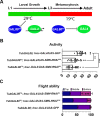Motor defects in a Drosophila model for spinal muscular atrophy result from SMN depletion during early neurogenesis
- PMID: 35877682
- PMCID: PMC9352204
- DOI: 10.1371/journal.pgen.1010325
Motor defects in a Drosophila model for spinal muscular atrophy result from SMN depletion during early neurogenesis
Abstract
Spinal muscular atrophy (SMA) is the most common autosomal recessive neurodegenerative disease, and is characterised by spinal motor neuron loss, impaired motor function and, often, premature death. Mutations and deletions in the widely expressed survival motor neuron 1 (SMN1) gene cause SMA; however, the mechanisms underlying the selectivity of motor neuron degeneration are not well understood. Although SMA is degenerative in nature, SMN function during embryonic and early postnatal development appears to be essential for motor neuron survival in animal models and humans. Notwithstanding, how developmental defects contribute to the subversion of postnatal and adult motor function remains elusive. Here, in a Drosophila SMA model, we show that neurodevelopmental defects precede gross locomotor dysfunction in larvae. Furthermore, to specifically address the relevance of SMN during neurogenesis and in neurogenic cell types, we show that SMN knockdown using neuroblast-specific and pan-neuronal drivers, but not differentiated neuron or glial cell drivers, impairs adult motor function. Using targeted knockdown, we further restricted SMN manipulation in neuroblasts to a defined time window. Our aim was to express specifically in the neuronal progenitor cell types that have not formed synapses, and thus a time that precedes neuromuscular junction formation and maturation. By restoring SMN levels in these distinct neuronal population, we partially rescue the larval locomotor defects of Smn mutants. Finally, combinatorial SMN knockdown in immature and mature neurons synergistically enhances the locomotor and survival phenotypes. Our in-vivo study is the first to directly rescue the motor defects of an SMA model by expressing Smn in an identifiable population of Drosophila neuroblasts and developing neurons, highlighting that neuronal sensitivity to SMN loss may arise before synapse establishment and nerve cell maturation.
Conflict of interest statement
The authors have declared that no competing interests exist.
Figures






Similar articles
-
Recapitulation of spinal motor neuron-specific disease phenotypes in a human cell model of spinal muscular atrophy.Cell Res. 2013 Mar;23(3):378-93. doi: 10.1038/cr.2012.166. Epub 2012 Dec 4. Cell Res. 2013. PMID: 23208423 Free PMC article.
-
Tissue-specific models of spinal muscular atrophy confirm a critical role of SMN in motor neurons from embryonic to adult stages.Hum Mol Genet. 2016 May 1;25(9):1728-38. doi: 10.1093/hmg/ddw044. Epub 2016 Feb 16. Hum Mol Genet. 2016. PMID: 26908606
-
Limited phenotypic effects of selectively augmenting the SMN protein in the neurons of a mouse model of severe spinal muscular atrophy.PLoS One. 2012;7(9):e46353. doi: 10.1371/journal.pone.0046353. Epub 2012 Sep 27. PLoS One. 2012. PMID: 23029491 Free PMC article.
-
Therapy development for spinal muscular atrophy in SMN independent targets.Neural Plast. 2012;2012:456478. doi: 10.1155/2012/456478. Epub 2012 May 31. Neural Plast. 2012. PMID: 22701806 Free PMC article. Review.
-
The Biochemistry of Survival Motor Neuron Protein Is Paving the Way to Novel Therapies for Spinal Muscle Atrophy.Biochemistry. 2020 Apr 14;59(14):1391-1397. doi: 10.1021/acs.biochem.9b01124. Epub 2020 Apr 2. Biochemistry. 2020. PMID: 32227847 Review.
Cited by
-
Neurodevelopmental defects as a primer of neurodegeneration: lessons from spinal muscular atrophy and Huntington's disease.Neural Regen Res. 2023 Sep;18(9):1952-1953. doi: 10.4103/1673-5374.367844. Neural Regen Res. 2023. PMID: 36926717 Free PMC article. No abstract available.
-
A nerve-wracking buzz: lessons from Drosophila models of peripheral neuropathy and axon degeneration.Front Aging Neurosci. 2023 Aug 8;15:1166146. doi: 10.3389/fnagi.2023.1166146. eCollection 2023. Front Aging Neurosci. 2023. PMID: 37614471 Free PMC article. Review.
-
Isogenic patient-derived organoids reveal early neurodevelopmental defects in spinal muscular atrophy initiation.Cell Rep Med. 2024 Aug 20;5(8):101659. doi: 10.1016/j.xcrm.2024.101659. Epub 2024 Jul 26. Cell Rep Med. 2024. PMID: 39067446 Free PMC article.
-
Drosophila melanogaster Neuromuscular Junction as a Model to Study Synaptopathies and Neuronal Autophagy.Methods Mol Biol. 2024;2761:97-120. doi: 10.1007/978-1-0716-3662-6_9. Methods Mol Biol. 2024. PMID: 38427233
-
Drosophila Models Reveal Properties of Mutant Lamins That Give Rise to Distinct Diseases.Cells. 2023 Apr 12;12(8):1142. doi: 10.3390/cells12081142. Cells. 2023. PMID: 37190051 Free PMC article.
References
MeSH terms
Substances
LinkOut - more resources
Full Text Sources
Medical
Molecular Biology Databases

